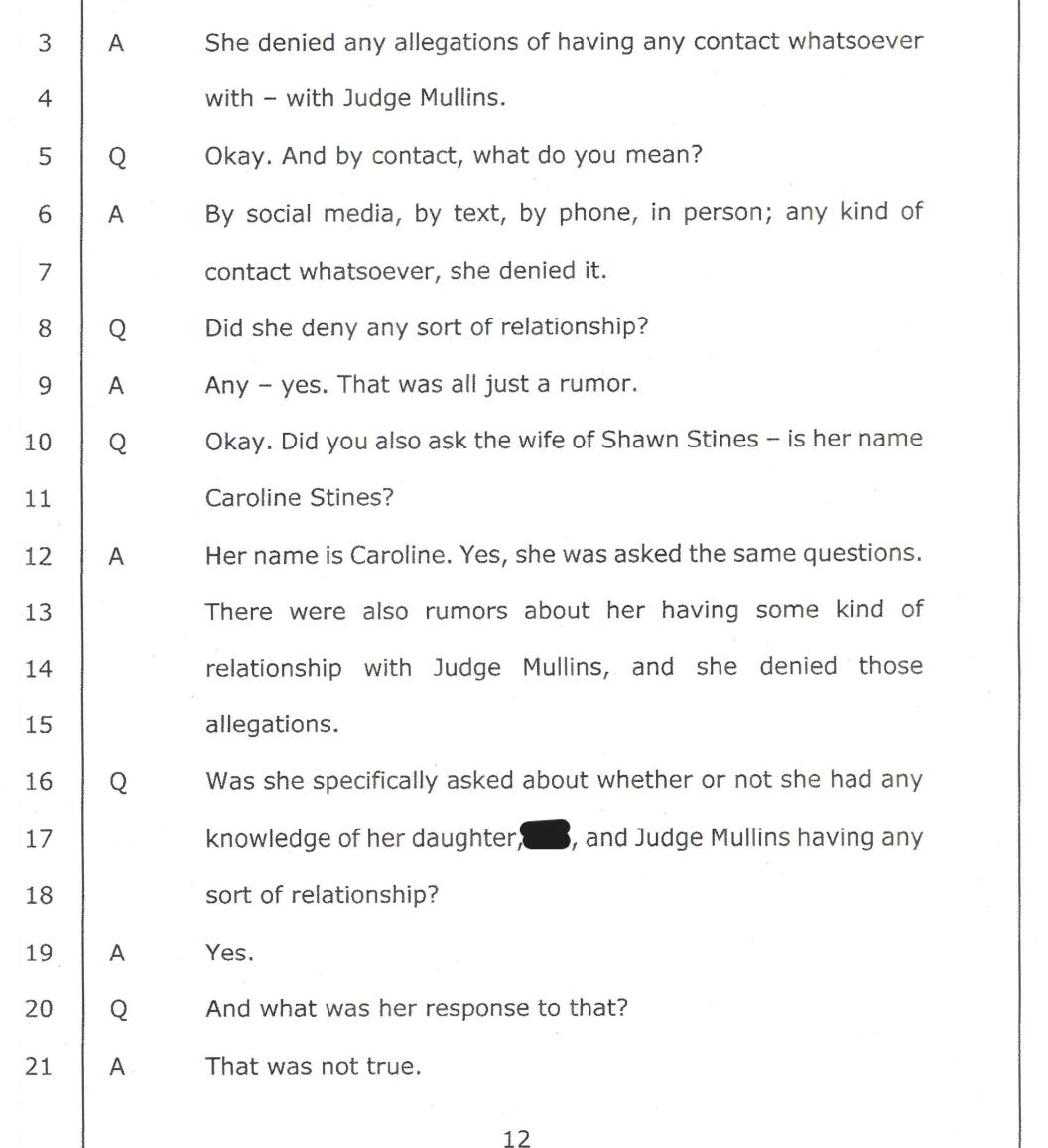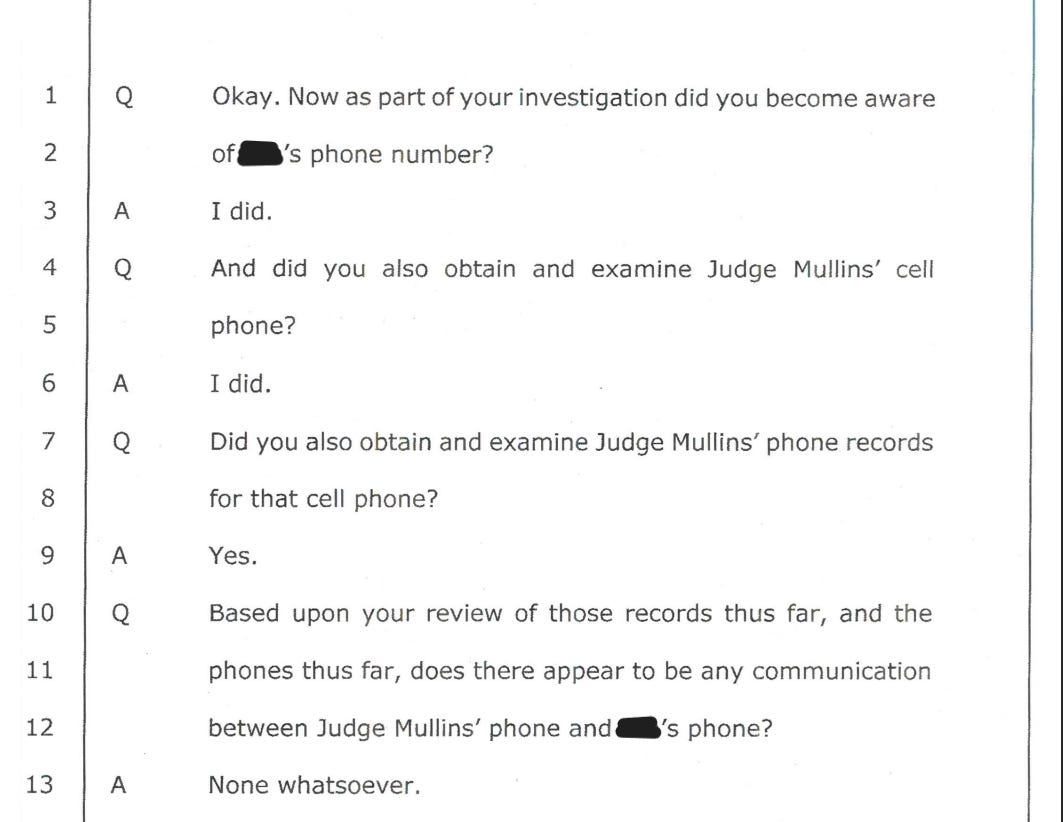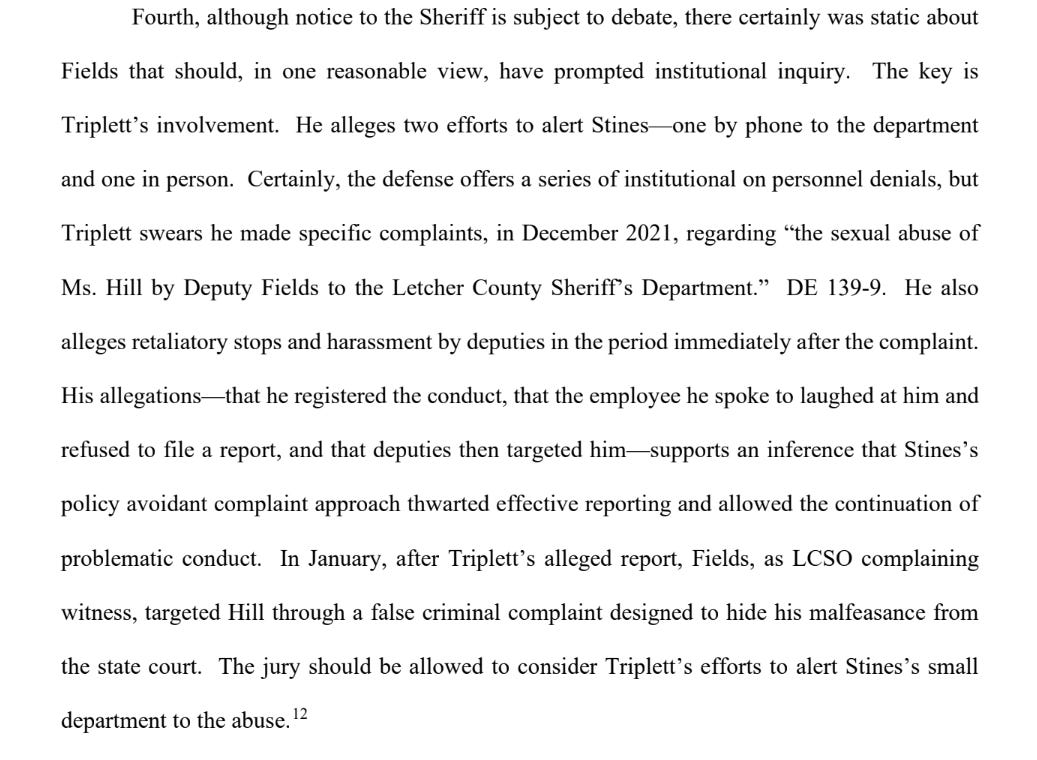The Sheriff Stines case is not what you probably think
But it's still very strange, and a mosquito bite may hold the answers.
When Letcher County Sheriff Shawn “Mickey” Stines was arrested for shooting and killing District Court Judge Kevin Mullins in his chambers in September 2024, the rumor mill went into overdrive. The shooting was caught on video and leaves no doubt that Stines committed it. But why?
Immediately after the killing, reporters highlighted a civil lawsuit in which Stines had been named as a defendant, which alleged that one of his deputies, Ben Fields, was coercing women he supervised on home detention to provide him with sexual favors. Fields ultimately pled guilty to rape, sodomy, tampering, and perjury charges related to the accusations. He was sentenced to six months in jail, which he served as a “trustee,” meaning he had special privileges to come and go from his cell when he pleased. Fields had apparently committed some of his crimes after hours in Judge Mullins’s chambers, leading to speculation that the Judge had been involved.
Then, it was announced that Stines had called his minor daughter from Judge Mullins’s phone immediately before the shooting. Confusion about the wording of the statement led many outlets to report incorrectly that the daughter’s number had been saved in the Judge’s phone. From there, speculation exploded that Judge Mullins had victimized Stines’s minor daughter and the shooting was a form of vigilante justice - fueled by Stines’s lawyer’s statements that Stines committed the killing under extreme emotional disturbance.
Contrary to this initial theory, however, subsequent filings in the case have confirmed that there is no record of any communication between Judge Mullins and Stines’s daughter.
The Stines family also publicly denied that Stines’s daughter had been sexually abused. But, as is often the case, the retraction received less attention than the initial story, and the narrative that Stines shot Judge Mullins in retaliation for abusing his daughter has probably become deep-rooted.
Another reason why this explanation for Stines’s actions has stuck is because the narrative provides a simple and understandable explanation of Stines’s motive. The reality of the case is far muddier.
First, while two former inmates and one jailer have accused Judge Mullins of participating in the sex abuse scheme, and a deputy sheriff testified in his deposition that Mullins was rumored to give sentencing favors in exchange for sexual favors, less attention has been given to Stines’s own potential complicity in the abuse scandal. The civil lawsuit filed against Fields and Stines alleges that Stines failed to adequately supervise Fields by ignoring policies on training and investigating complaints involving officer misconduct. Indeed, Stines had been the home detention supervisor before Fields and trained him in the position. Stines and Fields were friends, socializing outside the office at weekly gentleman’s poker parties Stines threw in his garage and participating in group chats exchanging sexual memes and banter. According to Stines, if someone had a complaint about a deputy, he expected the person to come and speak to him about it personally, despite the Sheriff’s Office policy stating that complaints could be made in any form to any person. Major decisions were often handled verbally despite policies calling for extensive written documentation.
The federal court, recently denying a motion for summary judgment by the Sheriff’s office and allowing the claims involving Stines to proceed to trial, noted that the plaintiff produced a witness who claimed to have twice attempted to report Fields’s abuse to Stines but his report was refused, and he was thereafter subjected to retaliatory stops and arrests by deputy sheriffs:
While this evidence, if true, doesn’t implicate Stines directly in participating in the abuse, it certainly tends to show he turned a blind eye to it at best and allowed his deputies to actively cover it up at worst. By his own account, as the supervisor, Stines admittedly did very little training or supervising and also set a very poor example for his deputies and staff by engaging in sexual jokes and banter with them.
But any connection between Stines’s murder of Judge Mullins in September 2024 and Fields’ sexual misconduct in January 2022 remains obscure. According to Stines’s deposition testimony, Stines only learned of Field’s misconduct when the civil suit was filed in January 2022, two and a half years before he shot Judge Mullins. If Stines knew about a coercive sex scheme involving female inmates, or at least didn’t care to look into it, why murder Judge Mullins so long after it came to light? If Stines wasn’t involved in it and didn’t know about it, why murder Judge Mullins at all?
The timeline of the lawsuit’s filing is also suspicious, suggesting an institutional effort to sweep Fields’ abuse under the rug. According to deposition testimony, a victim’s boyfriend first reported that Fields was having inappropriate relationships with two women he supervised, after he apparently saw text messages between them. The Circuit Court Judge Jimmy Craft as well as the drug court coordinator learned about his allegations in early to mid-January 2022 when the boyfriend filed a request for a restraining order against his girlfriend in Judge Mullins’s court. The order was granted, and the boyfriend then reported the girlfriend for violating it. Knowing that he had previously removed her monitoring bracelet and therefore could not confirm if she had gone to the boyfriend’s house in violation of the restraining order, Fields swore out a false arrest warrant for the woman for failing to report, of which Stines denied any knowledge, and she was arrested. Two weeks later, she filed the civil suit against Fields and Stines.
Stines claimed that he learned about the abuse only when a reporter contacted him about the lawsuit, and only then did the drug court coordinator and Judge Craft tell him they had known about the allegations against Fields and apologize for not telling him sooner. Stines recalled little else about his conversations that day with Fields, Judge Craft, the drug court coordinator, his staff, and others about this revelation, not even remembering if Fields admitted or denied the allegations. Thus, if Stines is to be believed, nobody bothered to tell him that his deputy was accused of a serious violation for at least two weeks, from about mid-January when the restraining order was requested until January 31st when the suit was filed, and then only after the press learned about the accusation.
The picture painted by the evidence surrounding the sex abuse claims is not pretty. The best case scenario is that nobody in positions of authority in the courts and the Sheriff’s office took seriously the risk that someone like Fields could abuse his power exactly as he did, as evidenced by a complete absence of training and supervision about sexual abuse and harassment, a policy of disregarding policies and complaints, and an admittedly inappropriately sexualized workplace in which Stines treated his deputies like boys in the locker room.
Most of this information about the sex abuse scandal in Letcher County comes from the civil case because, so far, the criminal case has remained tight-lipped about how, or even if, Stines’s murder of Judge Mullins fits in. Contrary to the perspective that the scandal is central to the case, much of the criminal case to this point has focused on Stines’s alleged psychosis at the time of the crime. A recent defense motion to dismiss the indictment based on allegations that prosecutors misled the grand jury highlights evidence that shortly after his arrest, Stines was diagnosed as being in active psychosis and prescribed antispychotic medications. Jail reports state that Stines appeared to be experiencing auditory or visual hallucinations (“internal stimuli”), lacked memory of recent events, and was combative and disoriented:
Other witnesses close to Stines describe strange behavior in the days leading up to the shooting. His attorney in the civil case reported being so alarmed by Stines’s demeanor that he contacted the bar association to find out what action he could take, told Stines to get a mental health evaluation, and after receiving a phone call from Stines the night before the shooting, told his wife Stines had “lost his mind.” Staff at the sheriff’s office shared the opinion that Stines was “off his rocker,” one reporting that Stines had told them his lawyer said to give him money and kill himself or “they” would kill his wife and daughter. Another said that Stines made her put on his bulletproof vest while he checked on his wife and daughter and that she and other staff took him to his doctor afterwards. Even his family concurred, with one aunt telling investigators that Stines had asked for them to check on his family after he saw someone walking on the street and that he had asked where his grandmother was the day of the shooting - but the grandmother had died several years before.
As if sudden psychosis in a man of over 40 isn’t odd enough, the explanation for it is even more strange. Three days before the shooting, Stines was deposed in the civil suit. At multiple times throughout the deposition he expressed confusion about the questions, and his attorney explained that he had California encephalitis, which caused him trouble when he was under stress. A mosquito-borne illness, California encephalitis is rare, typically asymptomatic, usually affects children, and can cause seizures and neurological symptoms. In one study of encephalitis with both autoimmune and infectious causes, as many as one-third of patients with infectious encephalitis suffered psychiatric symptoms - possibly explaining the subsequent reports that Stines was actively psychotic.
This is such a specific and obscure medical condition that it seems hard to believe it was made up. In anticipation of an insanity defense, Stines was psychologically evaluated by the Kentucky Correctional Psychiatric Center earlier this year and its report was filed under seal in July. Stines is now seeking to unseal that report and the Commonwealth is opposing it, suggesting its findings are beneficial to his position both in the court of public opinion and in pending motions, such as his request for bail to be set.
But, on the other hand, Stines’s description of his symptoms appears to be highly atypical. In his deposition, he claimed he was having “a bad episode” at the time that he was learning about Fields’ misconduct all the way back in early 2022. Encephalitis is an inflammation of the brain that usually resolves quickly, in a matter of days to weeks. Although long-term complications are possible, a sudden onset of psychosis years later in an adult male would be quite an unusual presentation of a rare disease that is usually only symptomatic in children, most of whom fully recover.
Still, if he did have the disease, there would presumably be a diagnosis in his medical records and a record of ongoing complaints and treatment for complications. Proving this history, then, is likely to be a critical factor in determining whether this seemingly highly improbable set of circumstances caused Stines to lose touch with reality and murder Judge Mullins.
So what is the real story here? Is it, as Stines’ attorney has previously suggested, a case of virus-induced psychotic paranoia exacerbated by Stines receiving threats over knowing too much about rampant sexual misconduct in the courthouse? Or is it perhaps a case of Stines, knowing that his own role in the wrongdoing was coming to light, desperately fabricating a history of mental illness to exonerate himself from responsibility?
Despite its age, the case is not proceeding quickly, and the prosecution has not yet revealed its own theory of Stines’s motive, if it even has one. Multiple motions remain pending, no trial date or even a future hearing has been scheduled, and the prosecutor has yet to make a final determination on whether the death penalty will be sought. Consequently, for the time being, the case continues to hold more questions than answers, and we may not know the answers until the case goes to trial - if it goes to trial. All that’s clear at this stage is that even though the original story of a father protecting his vulnerable daughter isn’t true, the real story, with mosquito-induced psychosis as the alleged trigger for the murder, is going to be weirder than we thought.
Special thanks to R&M Productions and grayspace for sharing their legal documents!






Agreed that he would HAVE TO have a medical history of CE before this could even be considered, but I hate to admit that considering the rarity of it, the exact typing of neurological symptoms with CE could be varied. Consider this: in other variants of encephalopathy symptoms can range from photophobia to skin rashes, to partial paralysis. It's a wide range. But again, there would have to be a marked, documented medical history to back this up, and if that does exist, why would someone have this diagnosis and constellation of symptoms and still choose to wear a badge and carry a loaded weapon each day? Kinda shows us that his negligence may have surpassed being a terrible boss and trainer. Normally a medical doctor who is aware of someone having recurrent occasions of encephalopathy would restrict driving privileges considering the possibility of focal seizures, vision impairment, confusion, ataxia, much less advising their patient that they would be revoking their gun permits. Then again, it's the Bible belt and we love that second amendment so who knows. I was absolutely sure there was A LOT more to this story from the start when it was made clear that he simply called his daughter, not that the judge had any connection to her. Apparently this is going to be a wild one. I can't imagine why defense wants med records unsealed unless he does have the medical records to back up this defense though. Still somewhat puzzled. Great write up. We miss you!
This case did immediately spark my curiosity, and the theories and rumors of vengeance for sexual abuse of his daughter, or some sort of retribution for a sex abuse scheme... well, those initially bold, emotional lines seemed to quickly be obscured and overwritten by about half a dozen other variables, and I decided I didn't know what the heck was goin on.
I would be interested to see what additional corruption and governmental criminality the strings of this entire incident / trial might might pull and unravel, though, and looking forward to your coverage of it of you choose to!